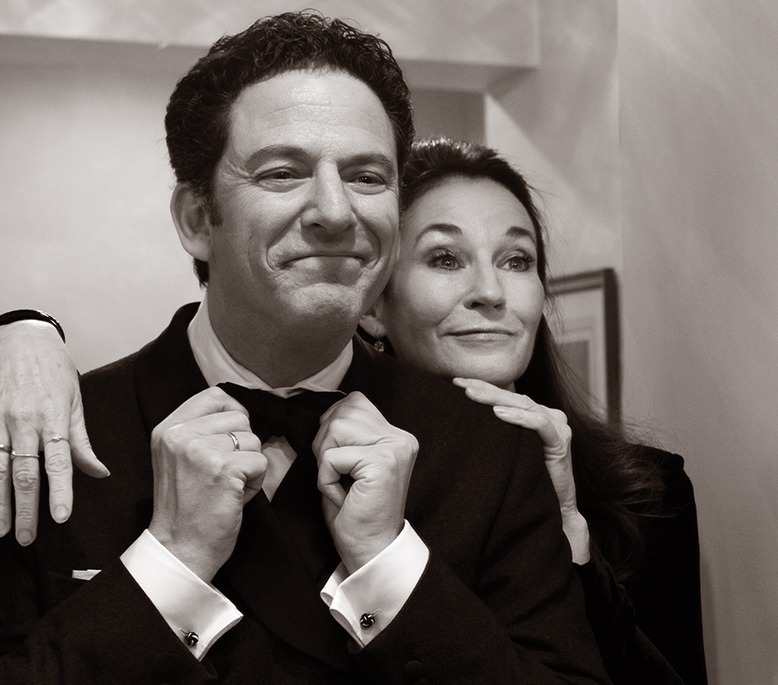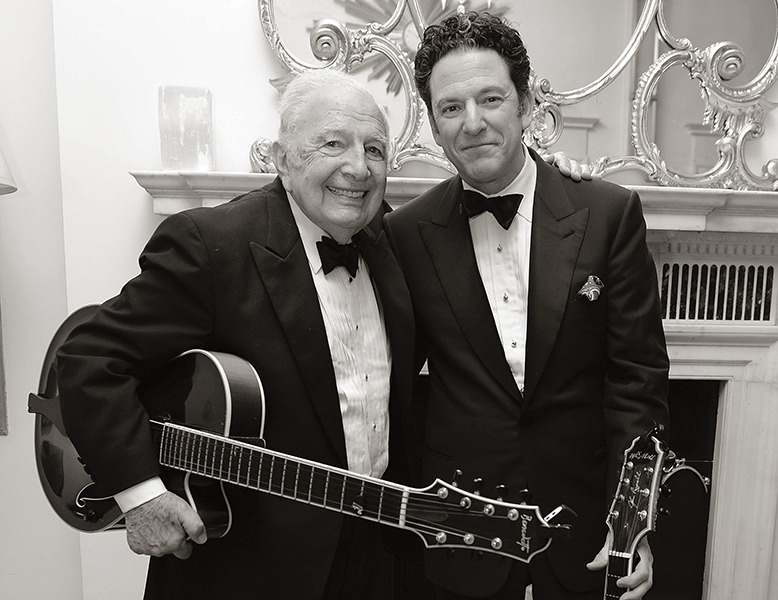
Jessica Molaskey recalls the first time she spotted future husband and performing partner John Pizzarelli scatting on TV: “He’s kinda cute!” Steve Freeman
Paterson-born guitarist John Pizzarelli connects to a Zoom video call from his lakeside cabin in Carmel, New York, about an hour north of the Manhattan apartment he shares with his wife, the actor and singer Jessica Molaskey, who’s sitting beside him. They’ve been holed up in the 1,200-square-foot space since March.
Compared to the walls of their Upper West Side brownstone apartment—generously adorned with jazz-centric art and ephemera, plus personal notes from the likes of Frank Sinatra and Stephen Sondheim—the wood paneling behind them looks sparse. When performing live, Pizzarelli is typically clean-shaven and in a crisp suit; these days, he sports a heavy quarantine beard.
Like the rest of the world, the couple’s lives were upended this year. In April, Pizzarelli lost his father, the legendary jazz guitarist Bucky Pizzarelli, to the coronavirus at the age of 94. Then his mother, Ruth (Bucky’s wife of 66 years), died exactly one week later—“almost to the hour,” Pizzarelli pointed out in a tribute episode of Radio Deluxe, the cozy music- and chitchat-fueled program he and Molaskey host weekly from their dining room table. (The show, turning 15 this month, airs in more than 60 cities worldwide.)
The inability to properly mourn with his siblings, sisters Anne and Mary and brother Martin, added to the sting of Pizzarelli losing his parents. “We haven’t been able to get together and even do anything yet,” Pizzarelli says, his eyes clouding over. “It’s still sort of surreal.”
***
Although he’s a New Yorker now, Pizzarelli, who grew up in Saddle River, is deeply rooted in New Jersey. He took banjo and guitar lessons with his great-uncles, Bobby and Pete Domenick, in Clifton and at Victor’s House of Music in Ridgewood. At Don Bosco Prep in Ramsey, he played in the marching band. His childhood home was a microcosm of the star-studded musical world of his father, an esteemed seven-string guitarist who “toured and recorded with jazz immortals” and “provided consummate accompaniment for a bevy of world-class singers,” as Bill Milkowski wrote in a 2015 profile in this magazine. A revolving door of colorful guests included guitarist Les Paul, who lived in Mahwah and stopped by often to jam; bassist Slam Stewart, an Englewood native who shared post-concert cookies and Ovaltine with Pizzarelli and younger brother Martin; and renowned bandleader Benny Goodman, who swam laps in the family pool and regularly napped on Bucky and Ruth’s bed.
Pizzarelli came of age in the 1970s, starting rock bands and hoping to become the next Peter Frampton. As a teenager, he began playing gigs with his father, who joked that his son was the only guy playing in jazz circles to support his rock ’n’ roll habit. But despite idolizing such artists as James Taylor and Paul McCartney (years later, he’d breathlessly collaborate with both), the younger Pizzarelli never fully embraced rebellion. In fact, he would go on to become one of the foremost standard-bearers for the music of his father’s generation—namely, the Great American Songbook (a canon of big band numbers, torch songs, and Broadway/jazz standards written by the likes of Cole Porter, Rodgers and Hammerstein, and the Gershwin brothers from roughly 1920–1950).
The crucial impetus came when Pizzarelli played a Frank Weber album for his father, who smiled and suggested he track down the Nat King Cole Trio records. “The easy tempo Nat achieved on ‘For Sentimental Reasons’ and ‘Route 66’ sounded every bit as rock ’n’ roll to me as Led Zeppelin II,” Pizzarelli recalls in his memoir, World on a String (Wiley, 2013). He ended up modeling his own jazz trio, with his brother Martin on bass, after Cole’s.

Pizzarelli performed with his father, Bucky, for decades; gigs included Manhattan’s Café Carlyle & Madison’s Shanghai Jazz. Andrew H. Walker/Getty Images
Pizzarelli performed on and off with his father for decades, playing gigs everywhere from the Morristown Library to the Garden State (now PNC) Arts Center. One memorable summertime commute in 1980, from Bergen County to Manhattan, saw father and son donning tuxes in the younger Pizzarelli’s Datsun 210—an econobox with no AC. Shanghai Jazz in Madison, where Bucky celebrated his 89th birthday, was a longtime mutual favorite.
In 1993, Pizzarelli’s trio was invited to open a world tour for fellow Jersey native Frank Sinatra. (Toward the end of his trio’s set, Pizzarelli writes in his book, Sinatra would sing-scream in the wings to warm up his voice. “Go home!” he’d bellow, grinning slyly.) After the tour’s last show at the Sands in Atlantic City, Pizzarelli headed to his parents’ home for a jam session “to make absolutely sure” he could still keep up with his father.
***
“Johnny’s got the table!” Pizzarelli interjects during our interview, glancing down at an incoming text. “Sorry—lots going on today,” he laughs. Johnny, his son from his first marriage to Maria Traversa, is moving the storied dining room table from Bucky and Ruth’s home into his own apartment.
“How many people sat at that table?” Molaskey wonders aloud.
“Can’t talk about it,” Pizzarelli declares. “Well, I can—I’m supposed to. I said to my son, ‘Benny Goodman sat in that chair. Zoot Sims sat in that chair.’ It’s really quite moving to me.”
Pizzarelli and Molaskey met in their mid-30s—and like so much of the music they espouse, their story was imbued with romance from the start. In 1995, Molaskey was performing in the San Francisco Opera’s production of Tommy. As she whipped up a plate of pasta in her apartment one night, she was listening to Jay Leno from her kitchen. “I heard this guy come out, and he just starts scatting like crazy. And I had to put my utensils down and go into the living room to see who was making that incredible music. Then I saw him, and I was like, Whoa, he’s kinda cute!”
Molaskey—who often describes herself as “an Irish-Catholic from Connecticut who should never scat”—would unexpectedly meet Pizzarelli the following year, when both were cast in the Broadway show Dream. When Molaskey rehearsed the show’s first big ballad, “Skylark,” she sang “so beautifully,” Pizzarelli recalls—but the musical arrangement “left a lot to be desired. It was the one time I went to the director, and I said, ‘This should be just guitar and voice.’”
And thus, a collaboration—one they’d soon be honing on stage and on the radio—was born. Come showtime for “Skylark,” all scenery was stripped away. The stage went bare—save for Molaskey singing and Pizzarelli strumming behind her. (The orchestra below eventually entered.)
By 1998, they were married and had a daughter, Madeleine. At their Manhattan-apartment wedding, both sang. Pizzarelli’s father played Irving Berlin’s “Always.” Tony Bennett showed up for the reception at an Irish bar around the corner—and stayed for four hours, posing for pictures with the giddy waitresses. (“Don’t anybody ask me to sing; I just got back from Europe,” he announced, to Pizzarelli’s dismay.) Their wedding song? “I Got Rhythm,” they answer in perfect unison.
In 2000, while performing together for the first time at the now-defunct Feinstein’s at Loews Regency in New York City, Pizzarelli and Molaskey realized their onstage dynamic—down to their unrehearsed, everyday dialogue—charmed audiences. They began shaping a joint cabaret show of sorts, melding music from the jazz and theater worlds and dreaming up medleys with modern songs and even original lyrics. They interspersed banter, stories and punchlines throughout. “It became something that’s really sort of singular to us,” Pizzarelli says.
When Tony Bennett appeared in their audience one night, Molaskey noticed his head kept tipping downward. Alarmed, she assumed he was nodding off. “I thought, God—we’re boring Bennett to tears!” she laughs. In fact, Bennett, also a serious painter, was sketching the couple on a cocktail napkin in his lap, which he presented to them afterward. It hangs framed in their city apartment.
***
As Pizzarelli and Molaskey await the opportunity to perform live again, Pizzarelli has begun playing virtual shows from the cabin. He collects requests on Facebook and Instagram early in the week, then strings together a setlist for Thursday livestreams at 6 pm. Molaskey pipes in, claps and harmonizes, mostly off camera.
These past few months, Pizzarelli admits, he’s been more inclined to break down while singing tunes from his lifelong repertoire (“Autumn in New York” being a recent example). “It’s really sort of embarrassing,” he says. “But the songs have completely different meanings now.” Adds Molaskey: “Look what we’re going through with these songs that our grandparents or great-grandparents gave us.”
Although more potent during a pandemic, the music’s enduring resonance—the way it elegantly lends itself to modern interpretations—is a thread both have long embraced. During their two-hour Radio Deluxe, still recorded weekly, the couple volleys songs and stories back and forth, drawing on their encyclopedic musical knowledge. Among public radio’s last remaining gatekeepers of the Great American Songbook, they spin the classics as recorded by the likes of Ella Fitzgerald, Louis Armstrong and Billie Holiday, but also its successors and sometimes interpreters, like James Taylor (himself an avid listener), Joni Mitchell and Bob Dylan. They might choose a Broadway ballad by Barbra Streisand for one show, a Marcus Mumford cover of Rodgers and Hammerstein’s “You’ll Never Walk Alone” for another.
On a recent segment in early autumn, the playlist spans from Sinatra’s “Misty” and Sarah Vaughan’s “I Let a Song Go Out of My Heart” to 30-year-old Benny Benack III’s jazz cover of the Mister Rogers theme, “Won’t You Be My Neighbor.” About halfway through the show, Pizzarelli introduces his next pick, a hushed version of “You and Me Against the World”—originally popularized by Helen Reddy in the ’70s—recorded in 2013 by Freddy Cole (younger brother of Nat).
“I tell ya—I don’t like to criticize anything,” Molaskey says hesitatingly. “I just never got that song. And then [Freddy] sang it one night, late in the middle of the evening, and I couldn’t…I lost it,” she recalls, her voice catching faintly.
“I know,” Pizzarelli says without missing a beat, and then the song begins.



